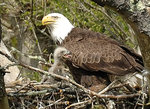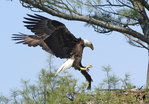 Narrowsburg
NarrowsburgLight Rain Fog/Mist, 43°
Wind: 8.1 mph
 Narrowsburg
NarrowsburgDuring the winter, the resident bald eagles have been enjoying their time off from breeding activities for the most part.
Some banded eagles, documented as part of territorial pairs in the …
Stay informed about your community and support local independent journalism.
Subscribe to The River Reporter today. click here
This item is available in full to subscribers.
Please log in to continue |


During the winter, the resident bald eagles have been enjoying their time off from breeding activities for the most part.
Some banded eagles, documented as part of territorial pairs in the Delaware River, have been observed in other areas of open water, such as the Mongaup River area. Many times these eagles, with the blue NYSDEC color bands, share the same perch trees and the same communal night roosts with the Canadian migrants that come to this region for the winter,
In late winter, the resident eagles start to prepare for the upcoming breeding season. Building new nests or repairing existing nests consumes more time. Courtship flights may be observed. Local eagles become more territorial and chase off other intruding eagles from their nest sites.
By the beginning of March, many pairs are incubating eggs. By the middle of April, many of the nests have hatched out. (Bald eagles incubate their eggs for 35 days before the eggs hatch.)
The newly hatched eaglets are very small—about five inches in length and about 3.5 ounces in weight. They are covered in their primary down, fluffy and off-white. During this time, they spend a lot of time under a brooding adult; there are some cold days in April, and eaglets cannot protect themselves from the cold at this early stage.
As eaglets get older, they develop secondary, or mesoptile, down; this appears after the first week or so and is battleship gray in color. This secondary down is longer and fluffier; it provides more protection from extreme weather.
At press time, most of the nests have young with mesoptile down. A few of the earlier-hatching nests show a few dark-brown contour feathers and some stubby feather shafts, which will become primary and secondary flight feathers as well as tail feathers.
If you see one of these active nests, keep your distance. It’s actually easier to see what’s going on in the nest when viewed from afar; you don’t have the upward slant angle to deal with, which happens when you’re too close.
From this point on, the eagles will grow at a more rapid rate. By early July, the young eagles will be 10-12 pounds and have a 6.5-foot wingspan. The birds will be very easy to spot from afar in the latter weeks in the nest.
The PA Game Commission has a couple of eagle cams up this year that you can watch; find one of them at https://hdontap.com/index.php/video/stream/hanover-bald-eagle-nest-live-cam.
Comments
No comments on this item Please log in to comment by clicking here